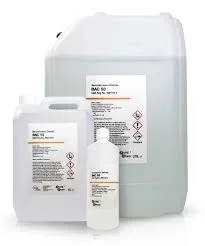poly aluminium chloride in wastewater treatment
Poly Aluminium Chloride in Wastewater Treatment
In the contemporary landscape of industrialization and urbanization, the management of wastewater has emerged as a pivotal challenge for environmental sustainability. One of the most effective and widely utilized coagulants in wastewater treatment is Poly Aluminium Chloride (PAC). This compound, a versatile inorganic polymer, is essential in clarifying water and removing impurities, making it an indispensable tool for wastewater treatment plants worldwide.
Poly Aluminium Chloride is synthesized from aluminium hydroxide and hydrochloric acid
. The resultant product is a white powder or a yellowish granular substance, depending on the specific formulation and the presence of other additives. Its high charge density and large molecular size contribute to its efficiency in neutralizing negatively charged colloids and suspended solids in water, leading to enhanced sedimentation.The primary function of PAC in wastewater treatment is coagulation. Coagulation is the process where fine particles suspended in water aggregate into larger flocs, which can then be easily removed. The use of PAC has several advantages over traditional coagulants like alum. Firstly, PAC operates effectively over a wide range of pH levels, making it suitable for various types of wastewater. This flexibility allows for optimal coagulation, regardless of the specific characteristics of the influent water.
Moreover, PAC demonstrates a higher degree of efficiency, requiring lower doses compared to alum. This not only reduces chemical costs but also minimizes sludge production, which is crucial for the operational efficiency of treatment systems. The generation of lesser sludge leads to reduced handling and disposal costs, making PAC a more economically viable option in many treatment scenarios.
poly aluminium chloride in wastewater treatment

Another significant benefit of using PAC is its rapid reaction time. PAC can form flocs swiftly, leading to quicker sedimentation and clarification of the water. This aspect is particularly beneficial in scenarios where time is of the essence, such as in emergency treatment situations or peak flow conditions in wastewater treatment processes.
Furthermore, PAC has been found to be effective in removing various contaminants, including heavy metals, phosphates, and organic matter. This multi-faceted approach to pollutant removal is vital in meeting regulatory requirements and ensuring the treated effluent is safe for discharge or reuse. In recent years, there has been a growing emphasis on resource recovery and the reuse of treated wastewater—PAC’s ability to enhance the overall quality of effluent plays a crucial role in these initiatives.
However, the successful integration of PAC in wastewater treatment processes is not without considerations. The choice of polymeric reagents needs to be carefully evaluated based on the specific characteristics of the wastewater being treated. The optimal dosage, pH adjustment, and mixing conditions must be established to maximize the efficiency of coagulation and flocculation processes.
Additionally, while PAC is generally considered safe for use, its long-term impacts on the environment and human health are still under scrutiny. Special attention must be paid to the residual levels of aluminium in treated water, and regular monitoring should be in place to ensure compliance with environmental standards.
In conclusion, Poly Aluminium Chloride has established itself as a crucial agent in the realm of wastewater treatment. Its effectiveness, cost efficiency, and flexibility make it a preferred choice for many treatment plants facing the arduous task of managing wastewater. As technological advancements continue to evolve within the field, the role of PAC in promoting sustainable water management practices will undoubtedly expand, addressing both current and future challenges in water quality management. Embracing such innovations is essential for safeguarding our water resources and ensuring a cleaner environment for generations to come.
-
Pbtc Scale InhibitorPBTC: A Scale Protector for Industrial Water TreatmentNewsAug.05,2025
-
Organic Phosphonate: An Efficient Defender in the Field of Scale InhibitionNewsAug.05,2025
-
Hydrolyzed Polymaleic Anhydride: Green Pioneer in Scale Inhibition FieldNewsAug.05,2025
-
PAPEMP Polyamino Polyether Methylene Phosphonic Acid For SaleNewsAug.05,2025
-
Flocculant Water Treatment: A Pioneer in Purification in the Field of Water TreatmentNewsAug.05,2025
-
Benzyl Isothiazolinone: An Efficient and Broad-Spectrum Antibacterial Protective GuardNewsAug.05,2025





